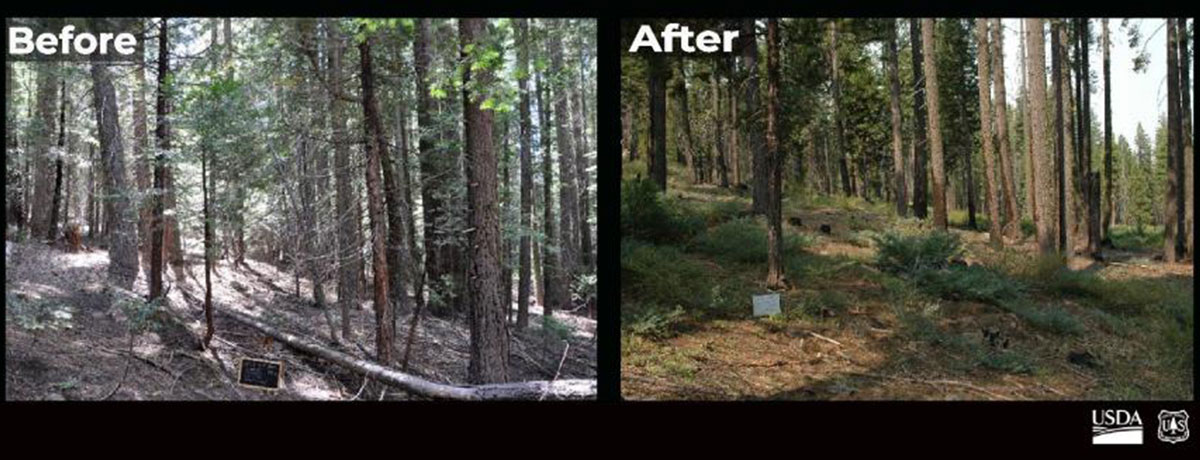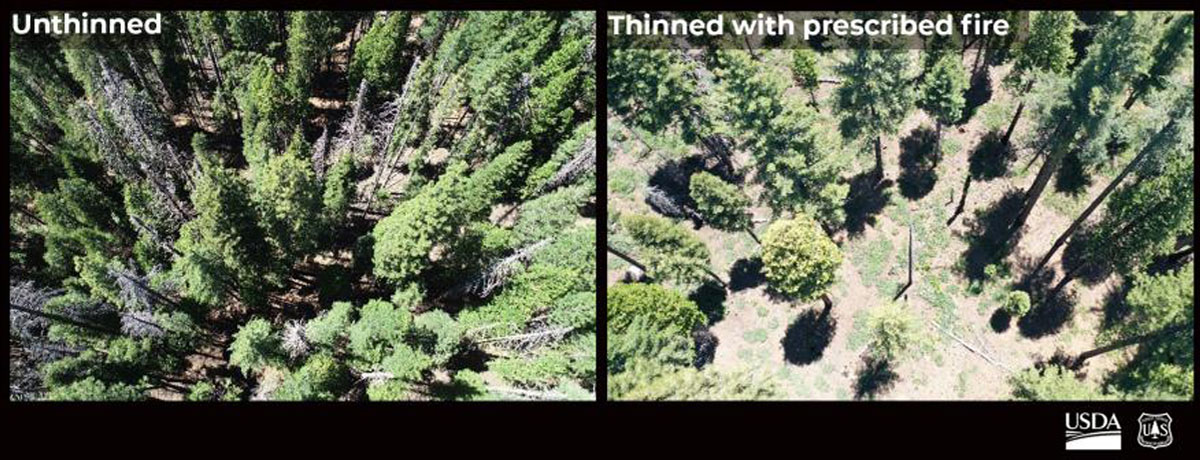Below is a news release from the U.S. Forest Service. The Rocky Mountain Elk Foundation sees eye-to-eye with scientists over many years that maintain active forest management provides enhanced elk habitat as well as improved overall forest health.
Overgrown forests are one of the key contributing factors to the current wildfire crisis in the West. The new Forest Service strategy on Confronting the Wildfire Crisis outlines the agency’s plan for increasing fuels and forest health treatments to create healthier forests and reduce the risk to communities.
Overgrown forests like the that on the left are a key contributor to the current wildfire crisis in the West. Such forests experienced extensive tree mortality during a recent drought. The thinned forest to the right, with gaps between pockets of trees, mimics historical forest conditions and experienced far less tree mortality during the same drought. USDA Forest Service photos by Adam Watts.
Forest Service science shows that thinning and fuels treatments work. Historically, many western forests were far less dense and extremely variable. Trees often grew in clusters of two to 20, interspersed with several small gaps. Pacific Southwest Research Station Research Ecologist Eric Knapp studies the ecology of western forests in relation to disturbance, particularly fire. He’s especially interested in landscape changes that have occurred in the absence of fire, including how resilient these forests are to drought or wildfire later. As part of this research, he evaluates the results of forest management alternatives designed to reverse some of these changes, including mechanical thinning and prescribed fire.

Ten years ago, Knapp and his colleagues began a study on the Stanislaus-Tuolumne Experimental Forest in California. They thinned some areas in the standard way, with trees spaced relatively evenly. They also thinned other areas with a new prescription designed to restore variability, mimicking historical forest conditions. Finally, they left other units unthinned. Half of all the units were later treated with prescribed fire. Since then, he and his team have been measuring the trees, understory vegetation, and small mammal populations to evaluate how the different treatments perform over time.
What they found was that during a recent severe drought that killed over 147 million trees statewide, the two thinned treatments came through relatively unscathed, experiencing far less tree mortality than the adjacent unthinned areas. By reducing competition, the remaining trees had greater access to sunlight, water and the nutrients found in soils. They also found that the addition of prescribed fire is key to a more vibrant and diverse understory plant community, similar to what these forests once contained.
Knapp and his colleagues have shared these findings through field tours for land managers and other stakeholders representing a diversity of interests.
“It has been gratifying to see that many have found the ‘high variability’ thinning idea with prescribed fire to be an example worthy of scaling up to improve forest resilience and habitat value,” he said.
Knapp is convinced that there are few better ways to improve understanding and acceptance of forest management than experiencing the various treatment options in person, but he believes that a virtual tour might be the next best thing. He’s now collaborating with Penn State University to develop a virtual reality field tour of the study area. Linking high resolution 360-degree imagery with audio commentary, the virtual tour allows users to explore the stands with a computer mouse.
The increased number of trees and accumulated fuels makes the forest shown in the left photo more vulnerable to drought and wildfire. The photo to the right shows the same forest after thinning and prescribed fire. This forest is more resilient to drought, wildfire and other disturbances. Left photo: USDA Forest Service photos by Adam Watts. Right photo: Courtesy photo from University of Nevada Reno.
“While there’s no substitute for actually being there, we’re hoping this virtual tour will make the forest more accessible to audiences that wouldn’t otherwise have the opportunity,” he said. An updated virtual tour should be available in a few months.
Forest thinning is seen by some as incompatible with healthy forests, but the forests of the past prove thinned forests can be both biodiverse and resilient in the face of drought and wildfire. Soon we’ll all be able to see the proof for ourselves.
(Photo credit: U.S. Forest Service)
